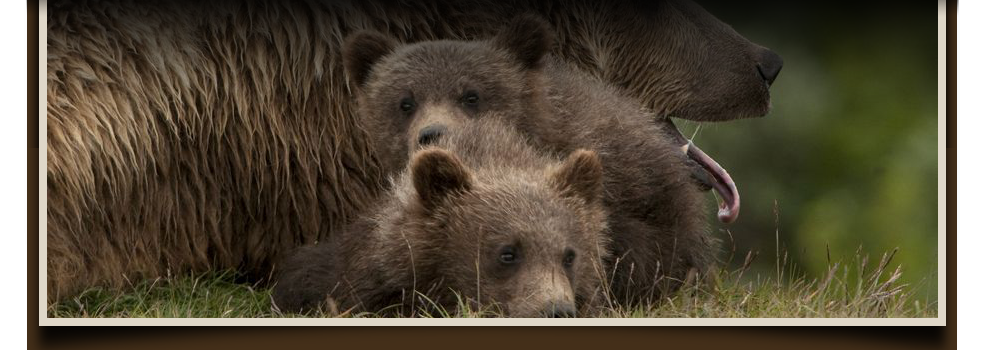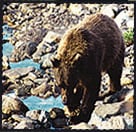
The Bear Facts
The Bear Facts
BEARS (Family Ursidae) Three species of bears inhabit North America: the Black Bear, the Grizzly Bear and the Polar Bear. Although all three species hold the essence of the power of earth, wind, water, fire, and freedom, it is the Grizzly Bear that is the transcending figure between this Earth and the Spirit World. Native Americans revere the bear, known to them as the Great Grizzly, and all that know him understand that he embodies all that is living and that of the Spirit World.
Classified as carnivores, the Grizzly Bear, Black Bear and Polar Bear are the largest of all terrestrial carnivores. While the Polar Bear is the purest of the carnivore trait, Black Bears and Grizzly Bears are really more omnivorous, meaning that their diets consist of both plants and meat. The Grizzly Bear and Black Bear enjoy the fruits of nature, from elk, moose, salmon and trout, to a decaying tree trunk filled with termites, to blueberries, huckleberries, and avocados. Bears also relish the morsels of man and will raid campsites, snatch a fish off the rod of a fly fisherman, knock down doors to get to the dinner table, and even do a little more “breaking and entering” if someone leaves a tasty treat in their car or backpack. The bears' sense of smell is remarkable and can detect the scent of food drifting on the winds from miles away.
Bears have five claws on each paw, and like Homo sapiens (man), they trek on their entire sole with their heels touching the ground. They can also stand on their powerful hind legs, often in an attempt to get a better view and smell of something that interests them or may threaten them. Bears do have good eyesight, but their olfactory sense is especially acute.
The female and male bears mate in late spring to early summer. Males will battle each other, many times in savage and ferocious fights, for a crack at a female. During the mating, the female eggs are fertilized; however, four or five months may go by before they embed into the uterine wall. At that time, they develop rapidly until birth. The female will usually only become pregnant if she has gained enough fat for the long winter ahead, usually only having births every other year.
Depending on climate, most bears hibernate for the winter, entering a protected place, such as a cave, burrowed cavern, or hollow tree trunk. They will sleep away the worst parts of winter. Their sleep is not a deep sleep, and their body temperature drops only a few degrees. In this state of hibernation, the female will give birth in her sleep to one or two cubs barely larger than the cup of a human hand, weighing only about 1/2 to 1 pound. The cubs are born in the darkness of the hibernation den and crawl up to nuzzle into their mother for warmth and to suckle her nipples for nutrients. They grow rapidly in the dark of winter, protected and nourished by their mother, only to emerge from their dens as wonderful bundles of fur and muscles, with a zeal for play and adventure. A mother Grizzly Bear will defend her cubs to her death in order to protect them from harm.
Bears are usually solitary in nature, but will congregate around rivers where salmon are returning to spawn, delving into the frigid waters for the delicious delicacies. Sub-adults will sometimes roam together when on adventures, like their human teenager counterparts, however, this is a dangerous time for them. They must learn about the perils of crossing roads, of poachers that will kill them for their paws, skins, and gallbladders, and about the dangers of other dominant adult bears. Just like human teens, teenage bears have a lot to learn at this stage of life.
Bears generally try to avoid humans, however they will confront man when they are hungry or injured, feel threatened or hunted, during the breeding period when the males are in a robust mood, and of course, when their cubs are nearby.
The Grizzly is a formidable, magnificent, and beautiful creature. Grizzlies walk with their giant claws extended which is the proud mark of BUSHLAND OUTFITTERS. These bears can tower over ten feet tall, and even up to a towering 14 feet. They can weigh up to 1700 pounds or even more, making them the largest terrestrial carnivore, and they can live up to thirty years or more. They can cover a hundred feet of ground in less than three seconds, crush the skull of a moose with a single swipe, and their powerful jaws can rip through a tree limb thicker than a man's arms.
The Grizzly Bear is distinguished by his large profile, with a dish-shaped face and a somewhat concave facial profile. He also has a large distinguished hump on his back shoulder area. His long sharp claws are perfect for digging and foraging for food. Feeding signs can be seen easily when trekking in bear country with signs of ripped open logs or rocks overturned where bears have been looking for grubs and insects. Berry patches are also a favorite feeding areas. Their usual M.O. is to eat large amounts of fruits and plants, and when they come across a dead animal, they are not averse to having a carrion meal of elk, moose and other animals. However, they are certainly capable of knocking down their own moose, elk, deer, or any other forest creature if it strikes their fancy. They’ve even been known to scratch their way through mounds of dirt to get a simple ground squirrel for a snack. Claw marks or bits of fur can often be seen on tree trunks where bears like to scratch their backs and mark their territory.
Bears are highly intelligent animals, and are actually a part of the canine family tree. So think of your dogs’ intelligence, and then multiply that by a factor or two and you see how smart bears are. They are truly magnificent, amazing creatures.

